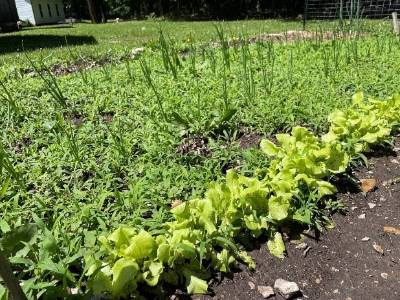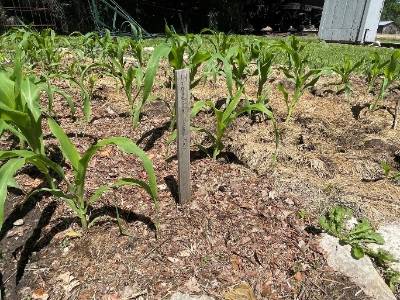Keeping up with the Weeds

We have all been there where our gardens look like this photo. It's easy to get busy, be gone on vacation, or the weather becomes too wet to allow us to safely get into the garden to keep up with the weeds. Unfortunately, all of our in-ground gardens have a weed seed bank in the soil that has built up over decades, and once you get behind weeding the garden, it can seem almost impossible to catch up. Here are some tips to help you stay ahead of the weeding during the summer.
- Weeds vs. Crops- One of the best steps to keep your garden weed-free is to provide an environment that favors the vegetables over the weeds. Plant your vegetables at the ideal times, fertilize them as needed so they grow vigorously and outcompete weeds, and use drip irrigation or soaker hoses to water only the vegetables. Do not water between rows where weeds will sprout.
- Cover the soil- The less soil surface that sees the sun, the fewer weeds you will have. Several options are available to cover your soil, from grass clippings (ensure you have not applied weed killer) to cardboard boxes flattened to weed mats; it all depends on your preference and how much you want to spend. This summer, I plan to use cardboard boxes as the base, then cover the cardboard with lawn clippings, leaves, and other composted materials to form a layer 4-5” thick to keep the soil constantly covered. Even if you do not cover the soil around the plants, try to cover the pathways and open spaces between the rows.

- Use cover crops- Cover crops are an excellent way to suppress weeds between plants, reduce compaction, and add nutrients to the soil. You can plant cover crops in the spring to suppress summer weeds or in the fall after the garden has come out to keep winter weeds from growing. Some common cover crops include winter wheat, annual ryegrass, clovers, vetches, peas, soybeans, and buckwheat. I also liked to mix in radishes or a root crop to help break up compacted soil.
- Use mechanical means- It is best to hoe, pull, or control weeds when they are small, but they are not the only mechanical method of controlling them. If you feel brave, using a flame weeder is an option (although I would avoid it if the weather turns dry) to control various weeds. One of my friends is trying a solar-powered weeding robot for her commercial vegetable garden. So far, she has had great success with her robot keeping up with the weeds and considers it a good investment, although it has a limited range of area it can cover.
- Chemical- Chemicals may be the best method of controlling some weeds, but they should be used cautiously. Glyphosphate products can be used in the garden; make sure to use regular glyphosphate, which is not an option with a residual. Another option is to use Preen or a similar product that prevents the weed seeds from germinating. If you plan to plant a fall garden, be sure any pre-emergent herbicide will have worn off before you plant your fall seeds. With any chemical application, be sure to read the label thoroughly and apply all products according to the label for your safety and the best growth of the garden.
Weeds will, unfortunately, always be a part of the gardening process. The best strategy is to use several methods to control the weeds in combination to achieve the best overall control. Do your best to prevent the weeds in your garden from flowering and going to seed, which will worsen the problem in the coming years. The best way to prevent weeds is to cover the ground with something to keep them from germinating. You can eventually win the war, but there will be several battles along the way.

Have questions? Contact our office where our Horticulture Extension Agent will assist you with questions.
Phone: (316) 321-9660
Email: callae@ksu.edu